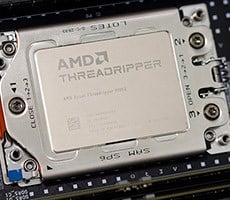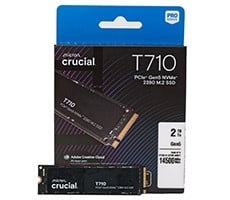AMD Ryzen Threadripper 9980X & 9970X Review: Bountiful Cores, Big Performance
UL Procyon AI Machine Vision Benchmark
Let's take a look at how these processors do with the UL Procyon AI Computer Vision benchmark, running solely on the CPU cores using Integer precision. Though many mobile processors like the the Zen 5-based Ryzen AI 300 series, Meteor Lake Core Ultra, and Snapdragon X processors feature an NPU, these workstation processors do not, hence all of these tests are being run on the CPU cores alone.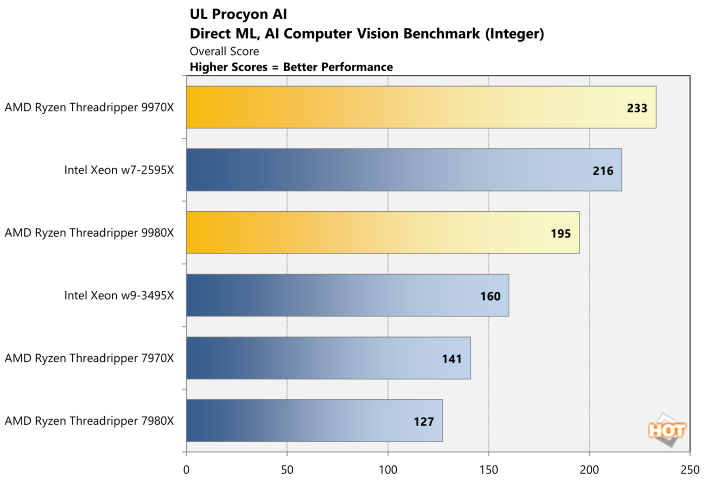
Procyon's computer vision benchmark doesn't leverage the many mores available in processors like the 9980X, 7980X, or Xeon w9-3495X, rather it benefits from the higher sustained frequencies attainable for the lower core count chips. Here, the Threadripper 9970X comes out on top, followed by the Xeon w7. Gen-over-gen the Threadripper 9000s are a significant step up over their Zen 4-based counterparts, however.
Geekbench AI Machine Learning Benchmarks
The Geekbench AI benchmark provides a straightforward look at how well a device handles a variety of AI-assisted tasks. This quick and easy test gives you a numerical snapshot of a CPU, GPU, or NPU's ability to power through real-world machine learning workloads, factoring in both speed and accuracy. The higher the score, the better the device's AI chops, whether it's image recognition, object detection, or natural language processing.Results are presented for three levels of numerical precision: single precision or FP32, half precision or FP16, and quantized or INT8. All results that the benchmark provides are geomean scores from multiple runs of each test workload.
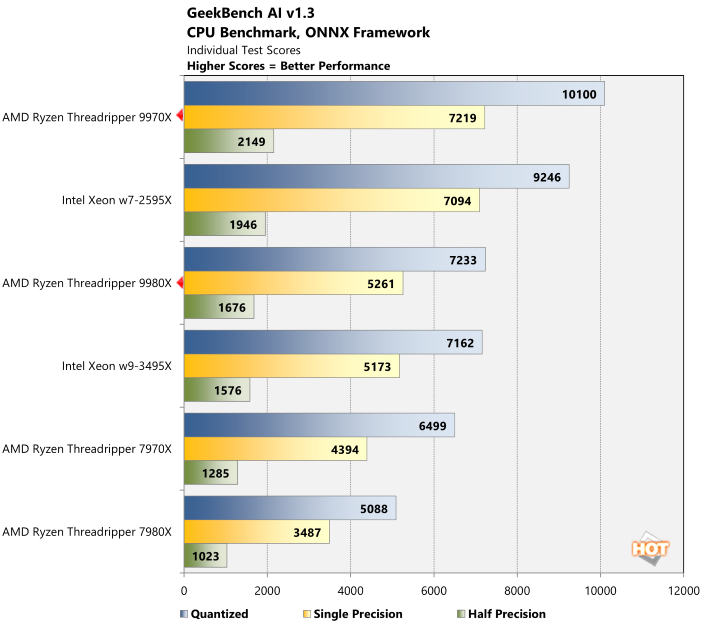
The scores are different, but the finishing positions are not. Once again we see the Threadripper 9970X taking the pole position, followed by the Xeon w7, and the Threadripper 9980X.
LAME XP Audio Encoding
In our custom LAME XP MP3 encoding test, we convert 24, large uncompressed WAV files to the MP3 format, which is a common use case for many end users, to provide portability and storage of their digital audio content. The LAME engine is an open-source MP3 audio encoder that is used widely in a multitude of third party applications. For this test, we created 24-copies of our own 223MB WAV file (an 11 minute Grateful Dead jam) and converted it to the MP3 format using the multi-thread capable LAME XP tool. Processing times are recorded below, listed in minutes:seconds. Shorter times equate to better performance.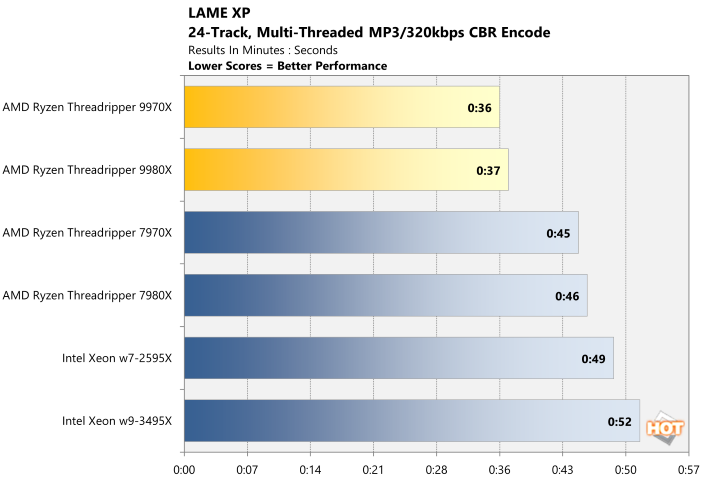
With only 24-tracks to work on simultaneously, this benchmark doesn't fully tax any of the processors represented here. Still, there's a clear performance trend with the Zen 5-based Threadripper 9000 series processors taking the overall lead.
Blackmagic RAW Video Processing Speed
The Blackmagic RAW Speed Test is a CPU and GPU benchmarking tool that tests full-resolution Blackmagic RAW video decode performance. The tool can be used to evaluate the performance at various resolutions and bitrates on the CPU or using OpenCL on a GPU. We're reporting two results here, both using 8K resolution, but at differing bitrates and compression levels.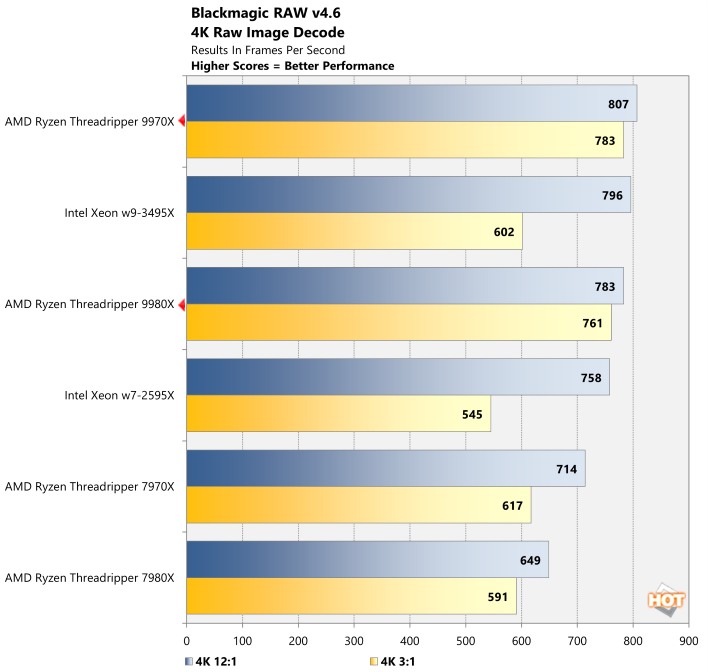
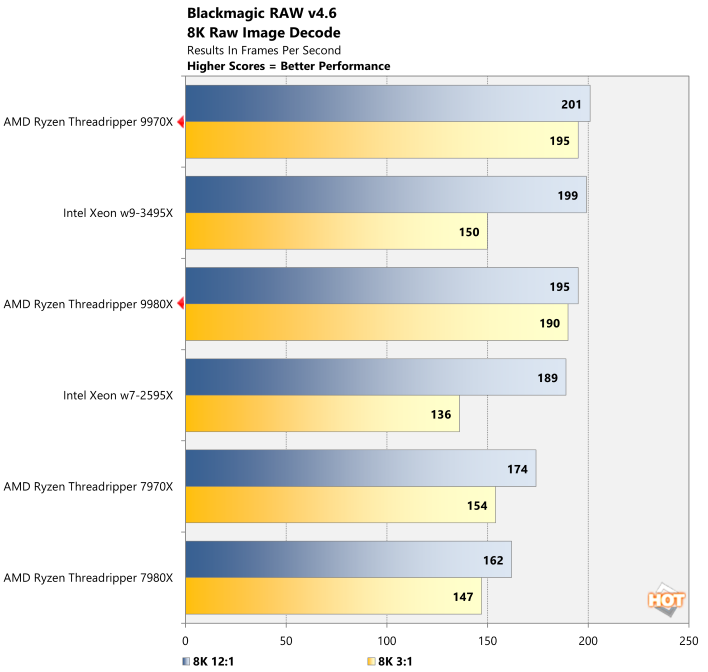
The Blackmagic Speed Test loves compute resources and memory bandwidth. In the 12:1 tests, the systems are less constrained by memory bandwidth, but there's no benefits with core counts beyond 32 and all of the top-end chips are grouped fairly tightly. In the 3:1 tests at both resolutions, however, the increased memory bandwidth afforded by the faster memory on the Threadripper 9980X and 9970X give them a clear advantage.
x265 Video Encoding Benchmark
The multi-threaded HWBOT x265 Benchmark is based on the open source x265 encoder that leverages modern CPU instructions to speed up video encoding. We tested the CPUs represented here with the 64-bit encoder using the default 1080p and 4K workloads.
This benchmark requires High Precision Event Timing to function properly, but our Xeon test bed was unstable when enabling HPET, so there's no Intel processors represented here. As you can see, the Threadripper 9000s take the top two spots yet again.
Cinebench 2024 Rendering Benchmark
Cinebench rendering performance test based on Cinema 4D from Maxon. Cinema 4D is a 3D rendering and animation tool suite used by animation houses and producers like Sony Animation and many others. It's very demanding of system processor resources and can utilize any number of threads, which makes it an excellent gauge of computational throughput. This is a multi-threaded, multi-processor aware benchmark that renders and animates 3D scenes and tracks the length of the entire process. The rate at which each test system was able to render the entire scene is represented in the graphs below.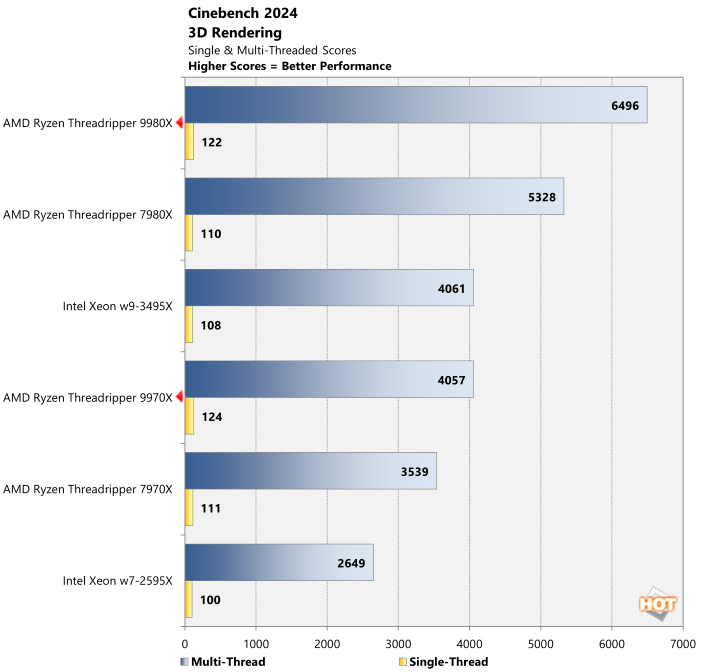
Cinebench 2024 is a showcase for the Threadripper 9980X and 9970X. These latest Threadripper offer the best singe and multi-threaded scores of the bunch, relative to thier core counts. The Threadripper 9980X is far and away the fastest workstation processor we've tested in this benchmark.
POV-Ray CPU Ray Tracing Benchmark
POV-Ray, or the Persistence of Vision Ray-Tracer, is an open source tool for creating realistically lit images. We tested with POV-Ray's standard 'one-CPU' and 'all-CPU' benchmarking tools on all of our test machines and recorded the scores reported for each. Results are measured in pixels-per-second throughput; higher scores equate to better performance.POV-Ray
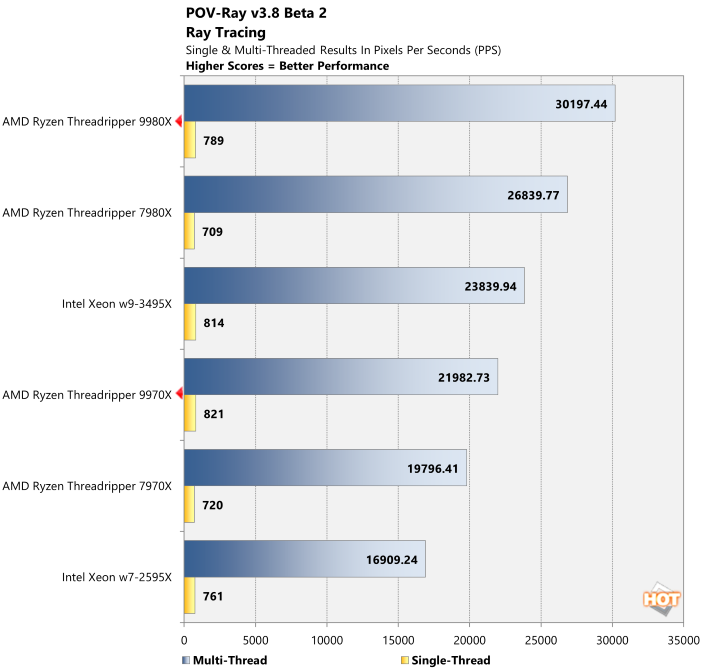
Things don't change much in POV-Ray in terms of the ranking, but the Xeon w9 does put up the best single-thread score here and it pulls further ahead of the Threadripper 9970X overall. Still the Threadripper 9980X and 9970X offer big leaps over their previous-gen counterparts and the 9980X dominates the multi-threaded test.
Corona 10 Render Benchmark
The Corona Benchmark is built on the Corona 10 rendering core and assesses system performance by rendering a scene using Corona 10. It determines the color of each pixel by sending rays into the scene and analyzing the materials, lights and other components and then shows a machine's performance in rays per second (rays/s), where higher values equal better performance.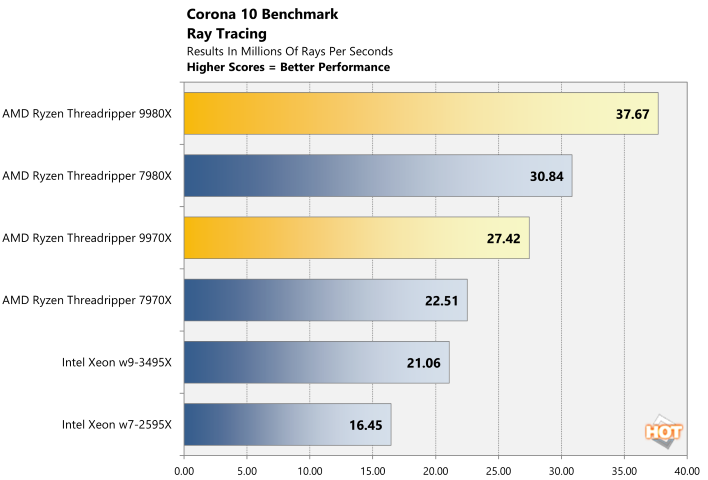
Once again we see the 32 core Threadrippers outrunning the 56 core Xeon w9. Focusing solely on the Threadrippers, the new 9000 series processors are over 20% faster than their predecessors
Blender Rendering Benchmarks
Blender is a free and open source 3D creation suite that can handle everything from modeling, rigging, and animation to simulation, rendering, compositing and motion tracking. It has a purpose-built benchmarking tool that will track the time it takes to complete rendering a particular model (or models). We used the CPU-focused benchmark with all three models currently available...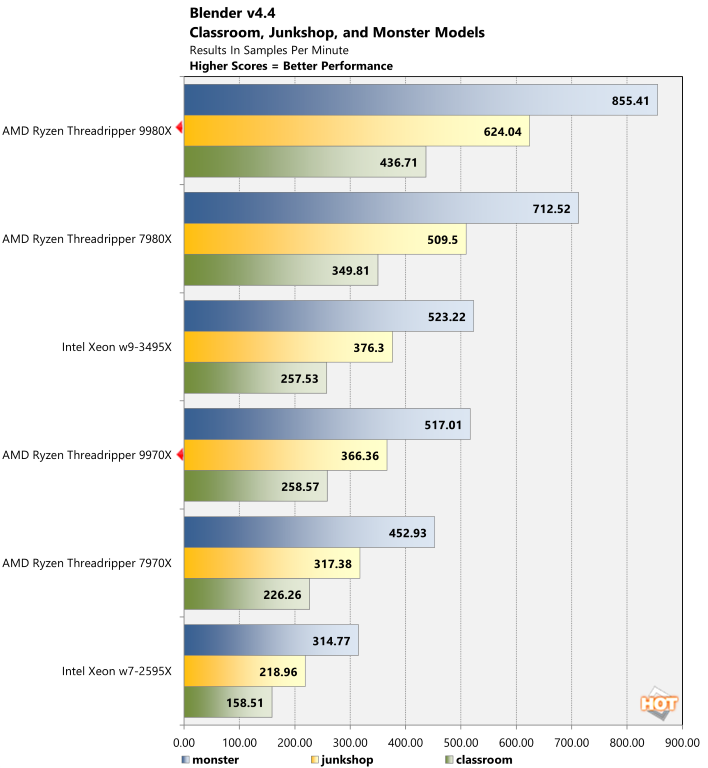
There's not catching the higher core count Threadrippers in the various scenes tested with the Blender benchmark. The Threadripper 9980X decimates all and both Threadripper 9000 series processors significantly outrun their previous-gen counterparts. On a per-core basis the Threadrippers crush the Xeons as well.
Y-Cruncher Multi-Threaded Pi Calculator
Y-Cruncher is a multi-core-capable tool that calculates the value of pi to a specified number of digits. In this case, we ran the tool on all threads and had the application calculate the value of pi to 1 billion digits. The values below are the time required to perform the calculation expressed in seconds. As a result, lower values indicate better performance.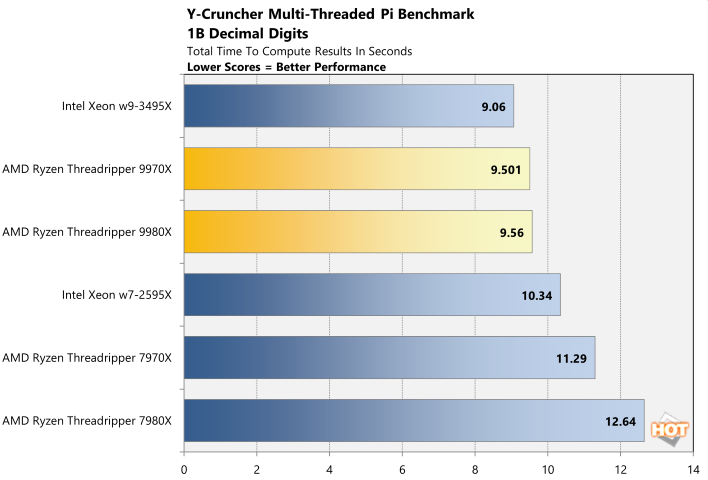
The Y-Cruncher benchmark runs particularly well on Intel's architecture and the Xeon w9-3495X is able to score its first victory, followed by the Threadripper 9000 series processors. Gen-over-gen though, these latest Threadrippers show huge gains, thanks to their newer architecture, higher clocks, and increased memory bandwidth.


